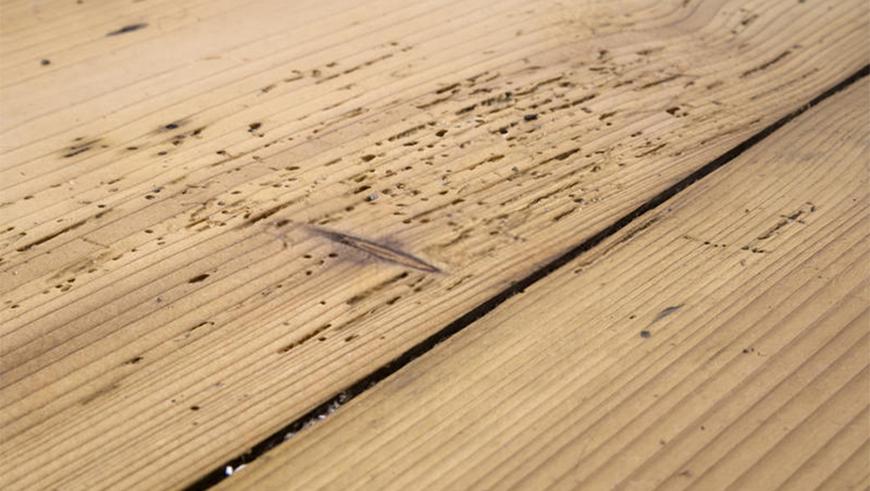Woodworm Treatment Cost
Last updated 27th February, 2024
Wondering how to treat woodworm?
In this article you'll discover everything about wood worm treatment. We discuss types of wood worms, woodworm treatment spray, how to find a woodworm specialist and more!
Continue for more...

How Much Does Woodworm Treatment Cost?
Woodworm is the larvae of wood-boring beetles, of which there are several different species in the UK. But the most damage is caused by the Common Furniture beetle larvae.
The main damage caused by woodworm can be tricky to spot initially as this damage is inside the timber, so you are unlikely to see any visible damage for some time, possibly even years after infestation. However, there are some signs that can help to identify an infestation, the most obvious being small holes in your woodwork and fine dust around these holes.
Woodworm can be found on all wood surfaces including of course roof beams, floorboards and rafters, but also in furniture. The amount of damage caused by woodworm depends on the species, the size or duration of the infestation, and the timber that has been infested.
Some species of woodworm are not particularly harmful, whereas others can seriously weaken timber and cause structural damage. Identifying the woodworm species is definitely a job best left to a professional.
Most modern woodworm treatments involve using various chemicals that can effectively kill wood eating insects of all types. These woodworm killers can be used on furniture, floorboards, structural timbers and roof rafters, they are easily absorbed deep into the wood offering good penetration.
Modern chemicals for woodworm treatment are mostly odourless and can be simply applied using a brush or a low-pressure sprayer to treat the wood and offer long-lasting protection.
Once you have discovered and identified woodworm in your home, you should not only treat this current infestation, you should also take steps to avoid future problems. Wood devouring insects have difficulty penetrating wood that is well painted or varnished, so if you know for sure that the timber is currently unaffected, you should start painting and/or varnishing all other wood in the property to prevent further infestation problems.
Although it can be difficult to completely prevent woodworm, you can definitely make things more difficult for them by keeping your home warm and well ventilated, keeping all wood dry and replacing any infected timbers as soon as possible. If you think you may have an infestation, it's really important to make sure you correctly identify the type you are dealing with.
Although woodworm can be treated as a DIY Project, it is essential to contact a specialist in the first instance to correctly identify the type of woodworm you are dealing with. Then if the woodworm only affects small non-structural items you can easily treat it yourself using "over the counter" woodworm treatment.
These treatments are available in brush or spray applications and should be used on any timbers you suspect may be affected by woodworm. But remember that with death watch beetle infestations these can be deep within a timber so it is important to use injection as well as surface treatments. This can actually be done without drilling holes simply by injecting into the small holes left by the adult beetles.
But for more serious cases, you can drill into the affected zones and fill the wood with the woodworm treatment. If you suspect that you might have a longhorn woodworm infestation then all timber within the home needs to be inspected for structural integrity and a free from severe damage can then be treated with over the counter woodworm killer.
It is vitally important that you deal completely with any woodworm infestation at the time. As if any affected timber is left untreated, then you are simply wasting your time and money. Woodworm is not actually caused by damp but damp does cause woodworm to thrive, so you should always keep your house warm and dry, monitoring the levels of damp using a timber moisture meter after you have treated any infestation.
Failure to completely deal with a woodworm problem by cutting corners will end up costing you much more in the long run. A common mistake is to simply brush on an over the counter treatment on the areas which are visibly affected by woodworm. You should always consult an expert to identify both the type and extent of the infestation, removing severely damaged timbers and carefully treating everything else - half measured are no good!
Woodworm Treatment Prices
The average material cost will vary depending on the woodworm treatment you buy. Prices start from £5 to £20 depending on how much you need and can easily be picked up from a local DIY shop or online.
The average specialist will usually charge around £100-£150 per day depending on location. Depending on the severity of the woodworm, the specialist should not take more than a few hours to treat the woodworm, but may have to continously treat the affected areas to ensure the woodworm is eradicated.
Below are some estimated costs of hiring a specialist to treat woodworm:
| Job Description | Avg. Cost | Duration |
|---|---|---|
| Treat your home for all stages of woodworm | £500-£800 | 1-3 days |
| Woodworm survey | £80-£200 | 2-4 hours |
| Treat furniture for woodworm | £70-£150 | 1 day |
Cost Breakdown
Individual costs to treat your home for all stages of woodworm - Total Cost: £500





